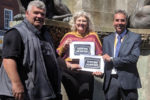The rate of people with high blood pressure on the Isle of Wight is among the highest in the country, as experts warn it may be the tip of the iceberg.
There were 25,404 patients with high blood pressure on doctors’ books under the Isle of Wight Clinical Commissioning Group (CCG) in 2016-17, the most recent year for which data is available, according to figures from Public Health England.
7.5% increase since 2009-10
It means that 17.7% of all those on the register have high blood pressure – the ninth-highest level in England. It is an increase of 7.5% on the rate in 2009-10, when figures were first recorded.
Maureen Talbot, senior cardiac nurse at the British Heart Foundation, said:
“Having high blood pressure can be deadly as, if left untreated, it significantly increases your risk of heart attack and stroke.
“And it’s much more common than you might think, with nearly one in three adults in the UK living with the condition. We estimate there are up to 7 million people in the UK with untreated or undiagnosed high blood pressure.
“The biggest problem with high blood pressure is that it’s silent there are rarely any signs or symptoms. That’s why its so important that people know their numbers, and seek advice and treatment if needed.”
Contributing factors
Poor diet, lack of exercise and drinking too much alcohol or coffee can all increase risk of high blood pressure.
All adults over 40 are recommended to have their blood pressure checked at least every five years.
However, the figures show that GPs on the Isle of Wight had no record of a blood pressure reading in the last five years for 7.8% of their patients over 45.
National comparisons
Across England, over 8 million people in 2016-17 were estimated to have recorded a high blood pressure reading, accounting for 13.8% of those registered with GPs surgeries.
Urban areas tended to have fewer people with high blood pressure, with Tower Hamlets having the lowest rates in England. Just 7.6% of people in the London borough had the condition, under half the rate in West Norfolk.
Article by Data Reporter, Joseph Hook, as part of the OnTheWight’s collaboration with Press Association and Urbs Media
Image: comedynose under CC BY 2.0





